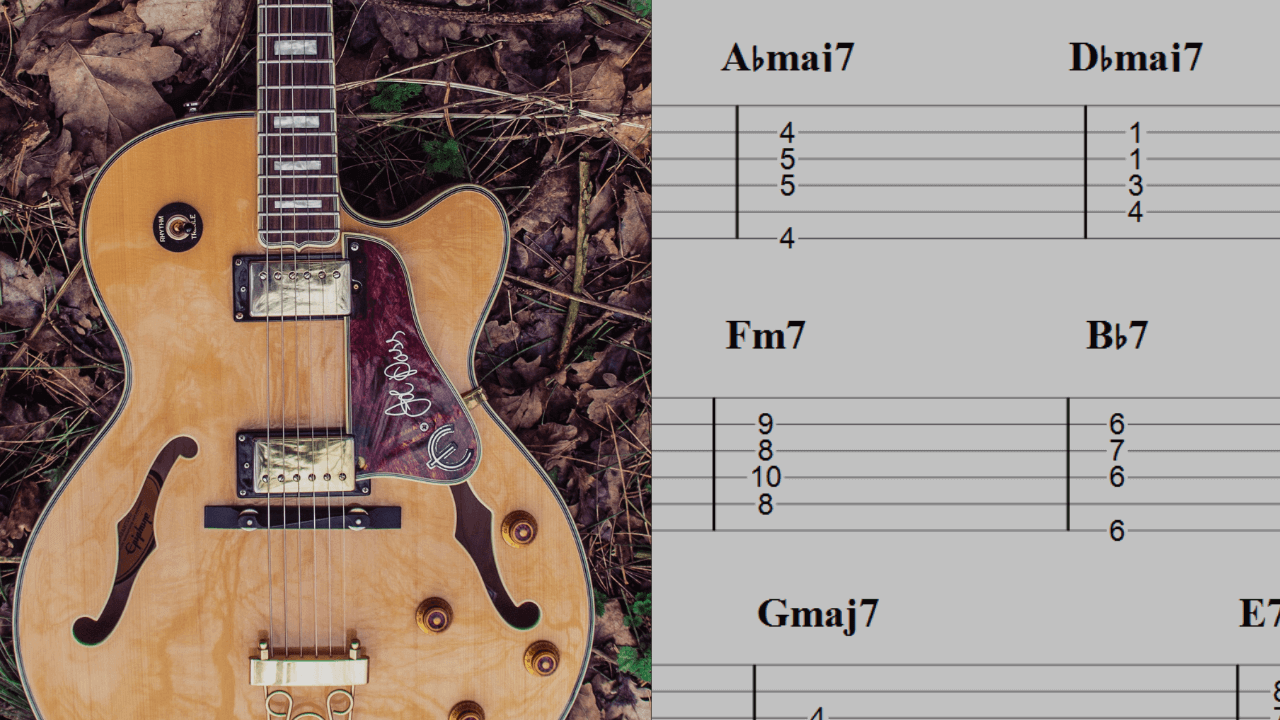What are the best guitar rock chord progressions?
The beauty of rock n’ roll chord progressions is that even though you still have to follow music theory concepts to make them sound correct, there is no set formula for creating them.
There are so many different iterations of rock music that it is just really hard to define the genre by only one specific sound.
Some of the basics are fast 8th note rhythms, and maybe some tendency to stay around a major key signature.
As you’re about to see, there are many chords and a lot of harmonies available to you if you want to create rock music of your own.
Let’s dive into what we think are the best guitar progressions that define the sound of rock music!
Table of Contents
- Early Rock N’ Roll
- Hard Rock & Punk Beginnings
- Metal & Alternative Rock
- You’ve Got Another Thing Coming (F#5 – D5 – B5- F#5)
- Ace Of Spades (E5 – B5 – Bb5 – A5)
- The Trooper (E5 – D5 – C5 – G5 – D5 – E5)
- My Bloody Valentine – Only Shallow (F5 – G5 – Bb5 – C5 – F5)
- Nirvana – Smells Like Teen Spirit (F5 – Bb5 – Ab5 – Db5)
- Them Bones (D5 – Eb5 – E5 – F5 – D5)
- Spoonman (C5 – D5 – C5 – A5 – G5 – F5 – D5 – G5 – D5)
- Killing In The Name
- NIN – March Of The Pigs (D5 – Ab5 – C5)
- Welcome To The Black Parade (G5 – G/F# – G/F – C5 – G5 – D5 – E5)
- Ocean Avenue (E5 – F#5 – D5)
Early Rock N’ Roll
Heartbreak Hotel (E – A – B)
As we go along in this article, you’ll see how far away we get from this familiar blues structure, but it’s very necessary to start here.
This popular song from the king of rock n’ roll, Elvis Presley, made a few simple adjustments to the blues format.
This song was released as a single on January 27, 1956, it was Presley‘s first on his new record label RCA Victor.
It’s known that it was written by Tommy Durden and Mae Boren Axton, but it also has credits being given to Presley.
When it comes to song composition details, this exact chord progression is only 8 bars, it uses no 7th chords, and it has an I-IV-V pattern.
Since the guitar is tuned in E, there are many ways to play this song but we suggest staying in the open positions as much as possible, in this case, for both the E and A major chords.
Johnny B Goode (Bb – Eb – Bb – F – Bb)
This chord progression became sort of the basis for so many rock songs after it came along!
Johnny B. Goode“ is a 1958 rock–and–roll song written and first recorded by Chuck Berry.
It was released as a single, and it peaked at number two on Billboard magazine‘s Hot R&B Sides chart and number eight on its Hot 100 chart.
This track is said to have set the pace and the rhythm for nearly every sub-genre that came in the future.
When it comes to the chord progression in itself, it’s in the key of Bb major and uses the I (Bb) – IV – (Eb) – V (F) pattern that’s used nearly everywhere in rock music.
This progression more closely follows the blues as it’s in 12 bars, and only goes back to Bb once; this is going to be one of the last progressions we see that stays close to this blues structure.
Proud Mary (D – A – Bm – D)
This chord progression is a great example of how you can stay close to the roots of rock music, but push it out just a little bit to explore new sounds.
These chords can be heard in Creedence Clearwater Revival’s “Proud Mary”, which uses an I – V – vi – I progression.
By using a minor chord along with the I and V chords, they’ve added a little touch of harmony that sets the entire song apart from the other two that we’ve talked about so far.
I recommend you use open chords as much as possible to play this song since the transitions are all going to be easier and smoother.
My Generation (F# – E)
Here is our first example that uses power chords.
This chord progression comes from The Who’s “My Generation” and uses a V-IV progression of F# to E.
There is absolutely no rule that says a rock song, or any song, must start and end on the I chord of the scale, you can start on nearly any chord you want, like with the V chord of B major for instance.
You’ll see this approach of starting on the IV or V in lots of rock songs as the Mixolydian mode (the one that starts on the V of a major key) is one of the most popular sounds of rock music.
Helter Skelter (E – G – A – E)
Before moving on to the next section of rock sub-genres, we couldn’t resist giving you one from The Beatles!
“Helter Skelter” is a song from their 1968 album “The Beatles” (also known as “the White Album”), it was written by Paul McCartney and credited to Lennon–McCartney.
It is recognized as having had a significant impact on the early development of heavy metal.
The chorus from this song uses a more familiar blues-type riff, but it’s the verse that we’re most interested in here.
By using I-bIII-IV-I chord progressions, we’re still using blues but throwing in a little chromaticism, which just means the use of notes foreign to the mode or diatonic scale upon which a composition is based.
This song’s use of G major clashes against the G# that’s in the E chord, that’s why it might sound a bit different from what we’re usually used to.
By using G and A together, it also suggests the sounds of D major where the IV chord is G and the V chord is A.
Hard Rock & Punk Beginnings
Paranoid (E5 – D5 – G5 – D5 – E5)
The next series of chord progressions will follow some familiar patterns too, but these will fall more into what we know as hard rock and punk music.
Just to be clear though, this doesn’t mean that these chords are specifically meant to be used for this sub-genre of rock, it’s simply an example of how previous musicians have used them in their songs.
The chord progression in question right now is a classic from Black Sabbath using an i-VII-III-VII-i chord pattern.
Lots of progressions will use some sort of combination of the VII and the III chords of a certain scale.
These are two of the strongest and most powerful chords to use together in a minor context like this one, and it adds a great layer of variety to the melody.
Remember we just talked about “Helter Skelter” by The Beatles? It used a III as well!
Whole Lotta Love (D5 – E5)
Although this Led Zeppelin riff seems simple harmonically, its rhythm and breakup have been a blueprint for thousands of riffs that came later after it.
“Whole Lotta Love” was released as a single in 1969 in several countries, it was certified gold in the United States and became the band’s first hit.
This song’s riff is easily distinguished because of its repetitive and catchy pattern.
If you hear closely, they play each chord in conjunction with the low open E note.
Lots of other bands like Iron Maiden, Metallica, Nirvana, etc. have used this rhythm and combination of playing techniques to come up with similar but interesting melodies of their own.
Cocaine (D5 – E5 – D5)
We are not kidding at all about how much this harmony is used in rock music.
It’s a crucial sound in rock music to combine the major chord at VII and the i chord, usually in power chord form.
This example from Eric Clapton’s “Cocaine” is one the most well-known classic rock riffs out there.
Although it just reuses many things we’ve already seen so far, they still managed to add their own feel and input into the whole sound.
If you‘re a songwriter, don‘t be afraid of recycling material that others have used before. You might be able to create something unique and special by taking inspiration from someone else‘s work.
There are only so many chords after all, and as they say, it’s very possible that whatever we come up with in the future, somebody else has already done it before.
Hotel California (Bm – F#7 – Asus2 – E7/G# – G – D – Em7 – F#7)
Let’s take a break from all the E5-D5 stuff concepts and dive into other forms of music that have made some of the greatest songs in history.
“Hotel California” is the title track from the Eagles’ album of the same name and was released as a single in February 1977.
This chord progression is much longer than any other we’ve seen so far and is set in the key of B minor.
If we want to talk about the harmonic format of this song by the Eagles, it will go as i-V7-VII-IV-VI-III-iv7-V7.
This time we get some familiar chords like the IV and III, but also some chromaticism by using V7 and IV.
We’re finally at a point where the common chords and harmonies are getting mixed up a little bit!
Ain’t Talkin Bout Love (Am – G)
This next progression comes from Van Halen’s first album; it consists of just two chords, Am and G.
Van Halen said that he came up with this riff by just hammering out these two chords for a while.
These two chords work great because, yet again, it’s the i and VII combined together.
This time, instead of E minor, we’re in A minor. So if you know your notes and your key signatures, you should be able to see how the VII is yet again recurring.
Sex Pistols – Holidays In The Sun (C5 – B5 – A5 – G5)
This classic punk rock progression takes the early rock sound and adds the iii and ii to make it sound a little different.
“Holidays In The Sun” was released on 14 October 1977 as the band’s fourth single, as well as the advanced single from their only album “Never Mind the Bollocks, Here’s the Sex Pistols.”
The Sex Pistols, the Ramones, and many other punk rock bands strove to recreate the sound of early rock music but to give it new life in a new context.
It didn’t take much to do this, they just put some other chords together aside from what they used before!
The Ramones – Blitzkrieg Bop (A – D – E)
The idea of using early rock sounds becomes quite apparent when you see this classic progression from The Ramones.
All they did was take the basic I-IV-V chords and use a faster rhythm and made the progression more compact.
If you’re a songwriter, this is a great concept to keep in mind.
Let’s say you want to use any of the progressions we’ve listed in this article, well, a great way to make them sound different can be by either speeding them up or slowing them down.
While “Johnny B Goode” and “Heartbreak Hotel” spread these chords out to 8-12 bars, the Ramones kept it to just 2 bars.
Metal & Alternative Rock
You’ve Got Another Thing Coming (F#5 – D5 – B5- F#5)
This chord progression comes from Judas Priest and uses more elements of the minor key signature than any other track we’ve seen so far.
These chords can be translated to i-VI-iv-i-III-iv.
A lot of metal and alternative rock is going to be moving into minor key signatures.
So it’s important to start becoming aware of the many chord choices available to you as we move forward to new subgenres.
You’ll start to hear that most rock songs, in the beginning, were all in major keys, and as new styles started to emerge, they began to use more minor chords and emotional sounds,
Ace Of Spades (E5 – B5 – Bb5 – A5)
Motorhead’s “Ace Of Spades” has another progression/riff that became a blueprint for many metal and hard rock songs.
This song was released as a single in October 1980, spent 13 weeks in the UK Singles Chart, and originally peaked at number 15 upon its initial release.
It’s using open E notes like in “Whole Lotta Love” but uses chromaticism by including the Bb/A# note as well.
Again, what’s really cool about hard rock and metal is how it combines elements of what you see here with the minor key chords that we talked about previously.
The Trooper (E5 – D5 – C5 – G5 – D5 – E5)
Remember the E5-D5? Well, it’s here again with some variations in this classic Iron Maiden riff.
What this progression does is add the VI into the mix of chords.
This totally makes it sound completely distinctive from the others, even though they’re basically in the same key and using the same chords.
You can compare Black Sabbath’s Paranoid to this song, and you’ll be able to understand this better.
Every sub-genre is mostly defined by similar sound qualities, and it’s up to you to add the elements necessary to make it unique.
My Bloody Valentine – Only Shallow (F5 – G5 – Bb5 – C5 – F5)
Notice how the length of the riffs is getting shorter and shorter yet again.
Although lots of shoegaze riffs, like this one from My Bloody Valentine, are not as long as “Johnny B Goode”, they do focus a lot on the atmosphere.
Shoegaze, by the way, is an indie and alternative rock subgenre distinguished by its ethereal blend of muffled vocals, guitar distortion and effects, feedback, and overwhelming volume.
Bands like My Bloody Valentine, Slowdive, and Ride mixed in many of the elements we’ve seen so far, but added lush chords like maj9s, sus2s, and #11s to the mix as well.
This is a good checkpoint that we can use in this article where you’ll start to notice a very abrupt break from the first few riffs we discussed.
Nirvana – Smells Like Teen Spirit (F5 – Bb5 – Ab5 – Db5)
No article about rock music is anywhere near complete without talking about this progression from Nirvana.
“Smells Like Teen Spirit” is the opening track and lead single from the band’s second album, Nevermind, which was released in 1991 on DGC Records.
The success of this song in particular was unexpected and caused the album Nevermind to go to the top of several charts at the beginning of 1992.
You can see this progression as being two i-iv changes, or as an i-iv-III-VI progression in F minor.
This song, and others in the grunge genre, go further into the minor key signature to find darker sounds.
We’ve seen hints of this with the previous progressions, but this is one of the first that goes all into that mode and type of songwriting.
Them Bones (D5 – Eb5 – E5 – F5 – D5)
Alice In Chains was another grunge band that mastered the concepts behind using all sorts of minor keys in their songs.
They also threw in a lot of chromaticism in progressions like this one from “Them Bones.”
Remember that chromaticism involves any chords or notes that don’t belong to the key in question.
Since the notes in D minor are D-E-F-G-A-Bb-C, the Eb chord doesn’t belong to the key, hence it’s referred to as a chromaticism.
Spoonman (C5 – D5 – C5 – A5 – G5 – F5 – D5 – G5 – D5)
The I-VII change has returned again, but this time in Drop D, and this is one of the main things that tend to stand out for me in this riff.
There’s a lot more going on with this one riff, but it’s all following the key of D minor.
“Spoonman” is a song by the American band Soundgarden, was written by frontman Chris Cornell, and it was released on February 15, 1994, as the first single from the band’s fourth studio album.
Surprisingly it’s not using any chromaticism, but it does have an unusual time signature of 7/4.
7/4 just means that every bar will have the equivalent of 7 quarter notes, which can translate into 18 eighth notes or 36 sixteenth notes.
Killing In The Name
For this progression, let’s take a look at the similarities between this one and the last two songs we mentioned.
We see the I-VII changes again, and we’ve got a lot of focus on the D note.
The magic of drop D is that it made a key of music, both D minor and major, so much more accessible to many guitarists.
Because of the tuning of the guitar in standard, many songs have been written mostly for G major/E minor, as well as A major and C major.
NIN – March Of The Pigs (D5 – Ab5 – C5)
This one is also a variation of the I-VII change but it has a slight change.
All Trent Reznor (lead vocalist and principal songwriter of the band) did was to throw in the Ab5 chord, which is the bIII chord in the key of D minor.
This is also another example of an odd time signature 7/8, so just like with 7/4, it’s telling us that we need to play 7 eighth notes or the equivalent.
It can be challenging to start playing and thinking in 7/8 or 7/4, but the rewards can be quite amazing since you’ll start to explore and create new ideas.
Welcome To The Black Parade (G5 – G/F# – G/F – C5 – G5 – D5 – E5)
Now we’re going to step back from the brink of dark harmonies and intricate rhythms.
We’ll be in a very known key of rock music with G major in this progression from My Chemical Romance’s “Welcome To The Black Parade.”
The new thing about this chord progression is the slash chords of G/F# and G/F.
There is a whole world of harmony behind chords like this one that we wish we could discuss in this article since it goes outside of the scope of our main topic.
But we suggest that you learn a few chord shapes like those, and start implementing them in riffs of your own.
Ocean Avenue (E5 – F#5 – D5)
The final example in our list of rock progressions consists of another drop D riff.
In this case, the chord progression will be that of E5-F#5-D5, which is part of the D major key this time.
Lots of pop-punk progressions gravitate more to major keys as this musical system is easier to make pop sounds with.
You can see this with the “Welcome To The Black Parade” riff from earlier too.
In a way, we’ve come back full circle to early rock music by using major keys!

Dad, husband, son, and guitarist. I’ve been playing guitar for 20 years. Passion for writing, painting, and photography. I love exploring nature, and spending time with my family. Currently have a Gretsch G5220 Electric Guitar as my main instrument.




